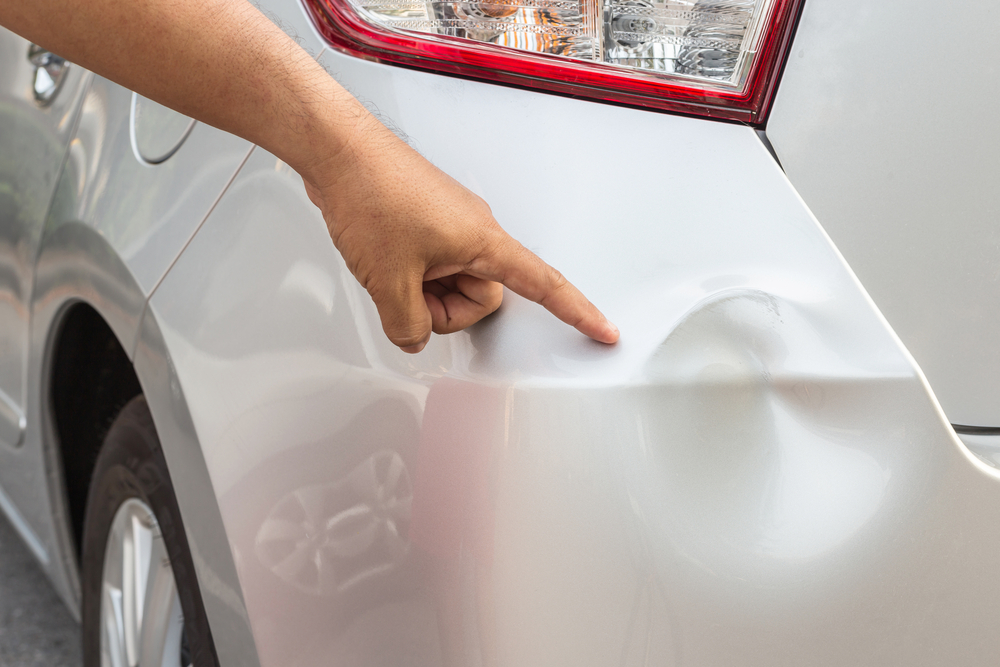What Is the PDR Glue Pull Process? How Does it Work?

When it comes to dent repair, not all removal methods are the same. Traditional dent repair, for example, can be damaging to the resale value of your car and costs more money due to the methods and materials used. Paintless dent repair (PDR), in contrast, is much more efficient, it doesn’t compromise the resale value, and it’s more affordable and better for the environment.
However, even PDR itself has a couple of different methods. Today, we’ll be specifically reviewing the glue pulling method and how the PDR glue pull process can benefit your vehicle.
Glue Pulling vs. Other PDR Methods
Generally, when a technician is evaluating dent and ding damage on a car, the question comes down to “should I pull or push the dent out?” And each method has its pros and cons.
When pushing a dent out, the technician will use a special bar to massage and push the dent out from behind on the backside of the body of the car. This method is most commonly used, but it is not necessarily the most effective for all dent or ding types or shapes. It does, however, offer more control and adaptability and is good for larger dents.
When pulling a dent out, the options are suction cups or glue pulling. Glue pulling is not as common because it takes a little more time and effort, but this method is gaining in popularity because it can be quite effective at removing dents and dings. With glue pulling, you can more easily access and repair the damage without having to remove parts of the car to get to the backside of the body.
How Does Glue Pulling Work to Remove Dents?
So, how does glue pulling work exactly? Unlike the straightforward process of pushing a dent out with a dent bar, glue pulling does require more tools and effort.
When a technician decides to opt for the glue pulling method, they will first have to pick which tools to use. This includes a slide hammer (good for very large dents), a dent lifter (good for hail dents and dings), or a t-bar (good for consistent pressure pulls). Next, they will choose something called a glue tab, which can vary in size and shape to help fit the tab to the size of the dent.
Once the appropriate tools have been chosen, the basic glue pulling dent removal process is as follows:
- Clean and prep the area
- Apply hot glue to a tab and place the tab in the center of the dent or ding.
- Allow the glue to cool and set.
- Attach the slide hammer, dent lifter, or t-bar to the tab and pull until the tab “pops.”
- After the tab has popped and pulled the dent out, remove any excess glue left behind with rubbing alcohol.
Pros and Cons of Glue Pulling Dent Repair
The benefits of using glue pulling are:
- Saves time: Though getting the tab in place and waiting for the glue to set takes more time, once the glue is ready, all it takes is one good pull to get the dent out. With a dent bar, technicians have to first disassemble the car to reach the backside of the dent, and it can then take time to massage and press the dent out.
- More strength: Glue has a lot more strength to hold onto a dent and pull it out. Plus, the tools used for dent pulling also help do a lot of the work. This makes it more efficient for tough, stubborn dents that don’t want to budge. With dent bars, however, technicians rely on their own strength to push the dent out.
Disadvantages of glue pulling:
- Not efficient in all weather: Glue loses its strength when exposed to higher temperatures. So if it’s summer or the repair shop tends to run warm, it might make glue pulling more of a challenge.
- Risk of damaging paint: While PDR methods are considered the best option as they won’t compromise the vehicle’s paint finish, glue pulling, of all PDR methods, can sometimes result in some paint being lifted. Generally, cleaner, factory finish paint jobs have the lowest risk. In contrast, old car paint that is chipping or damaged already will be more susceptible to paint being removed with glue pulling.
Killa Dent Removal
At Killa Dent Removal, our paintless dent removal specialists will thoroughly evaluate your vehicle to determine the best method. This can include using a dent bar to push dents out or using glue pulling. Our technicians are highly skilled, and we always back our work with 100% satisfaction guaranteed.
For a FREE estimate, contact us today!
(317) 480-9433
Or Stop By:
Killa Dent Removal
7807 W Morris St, Indianapolis, IN 46231



